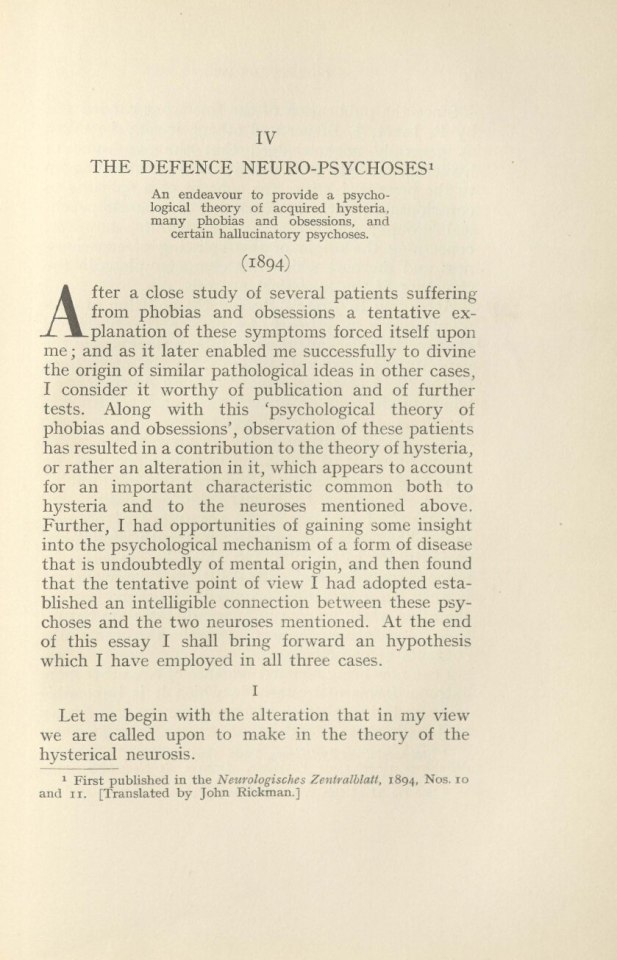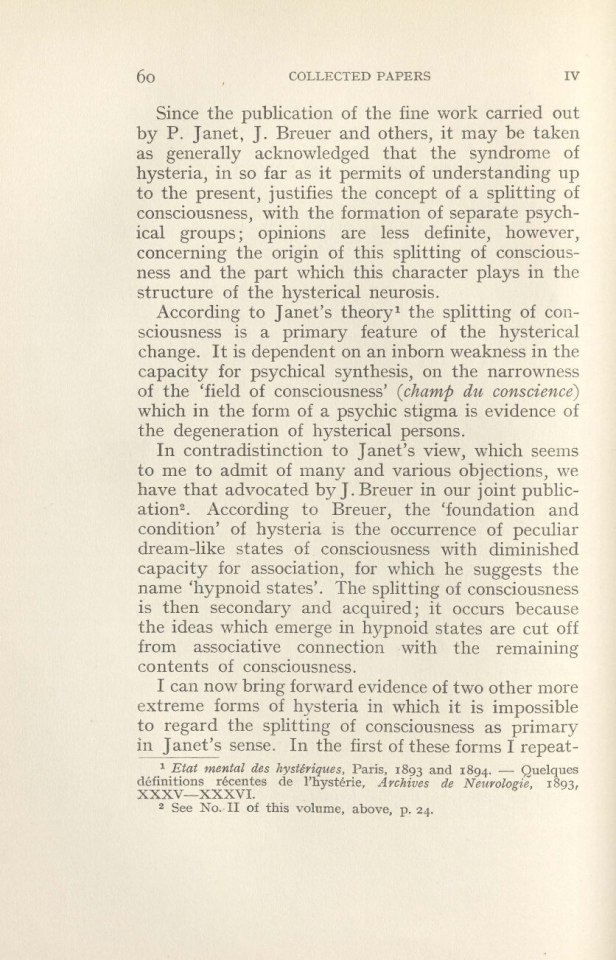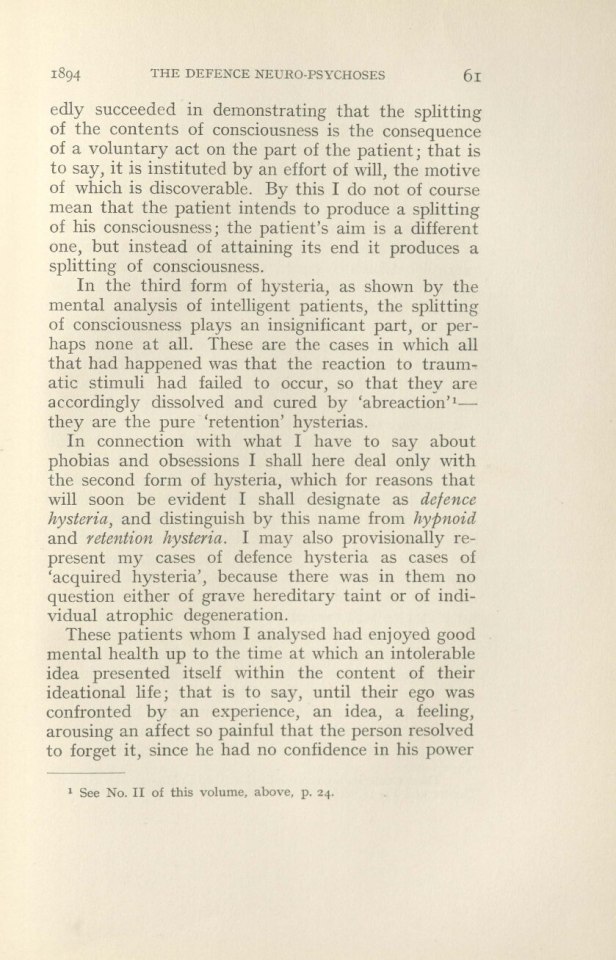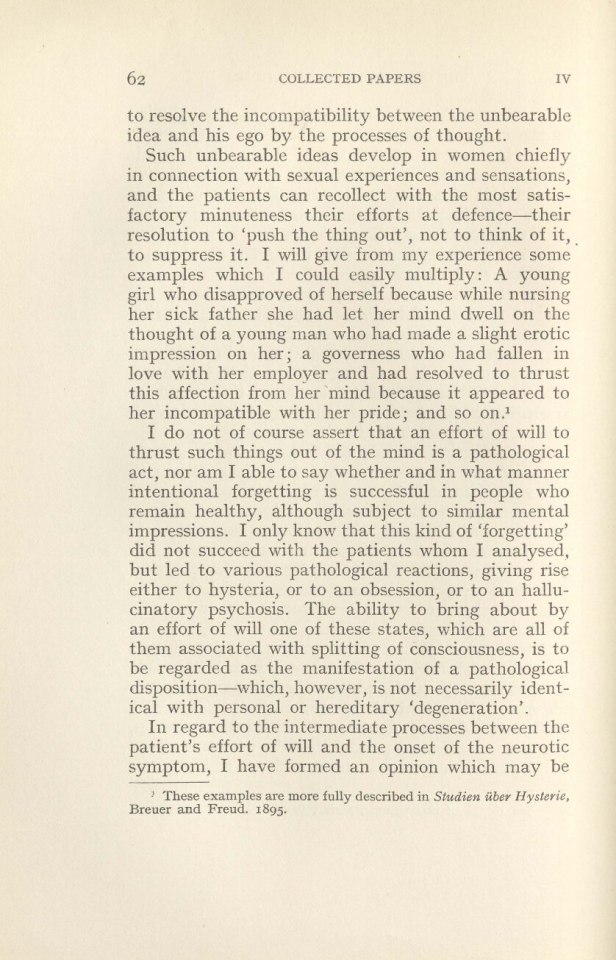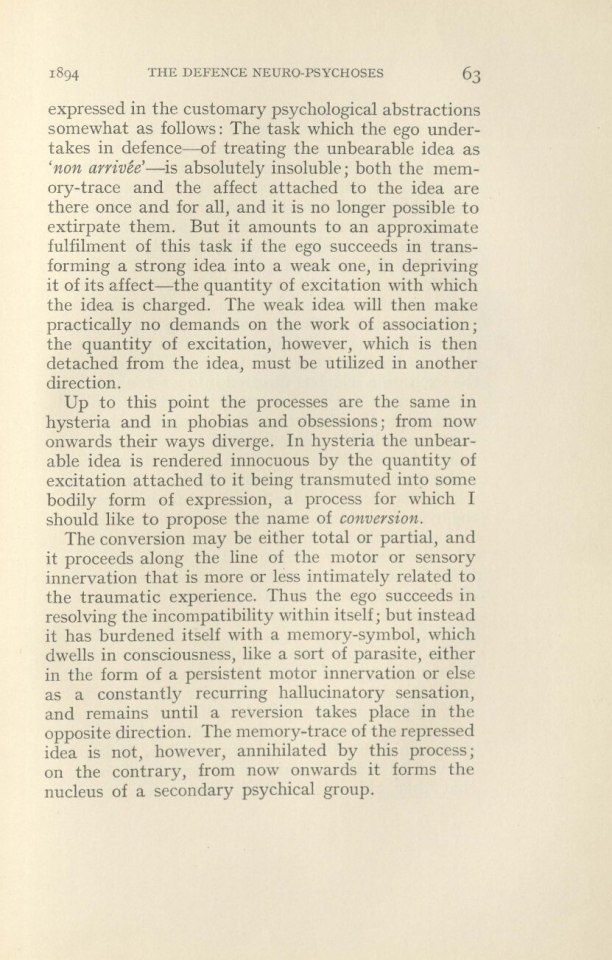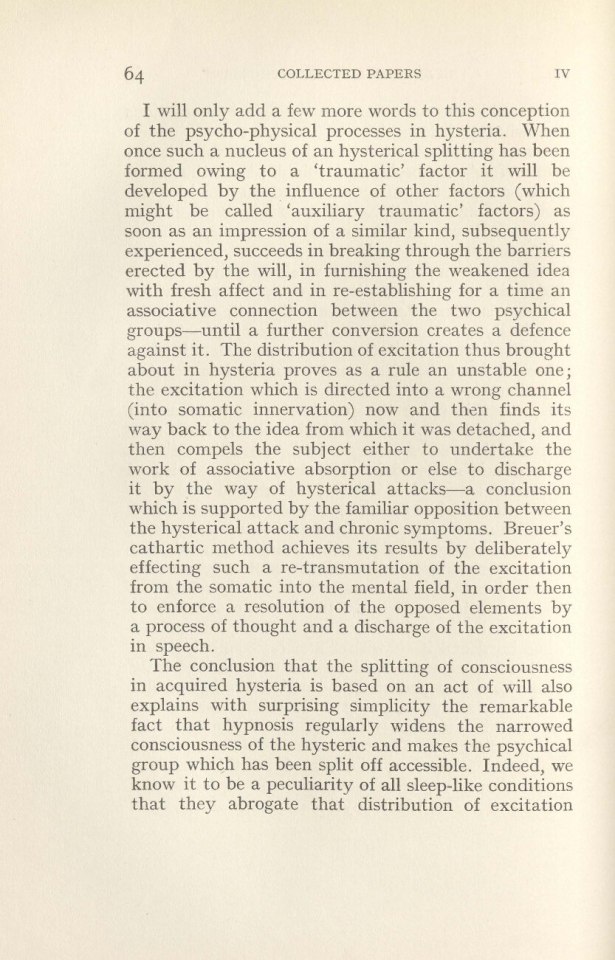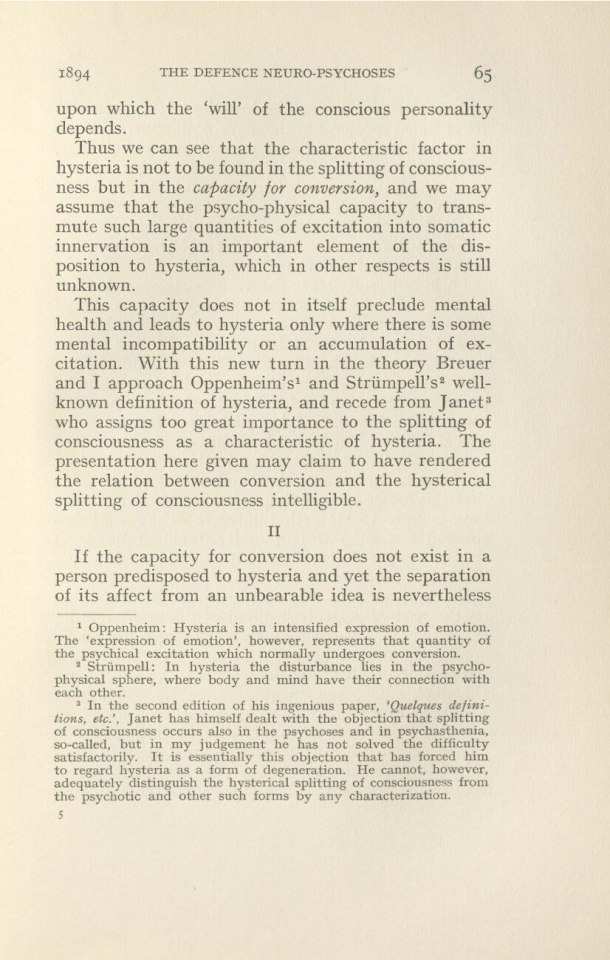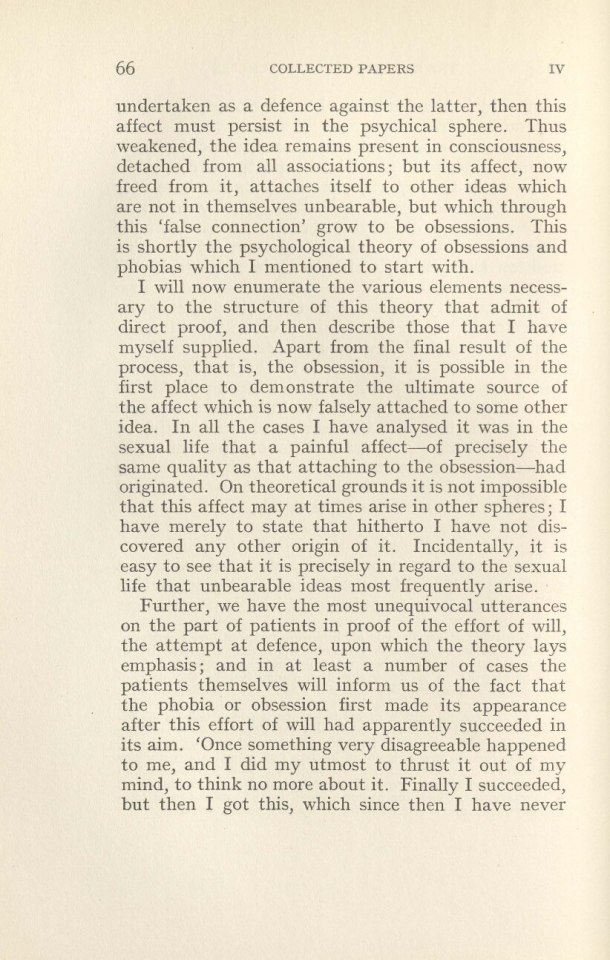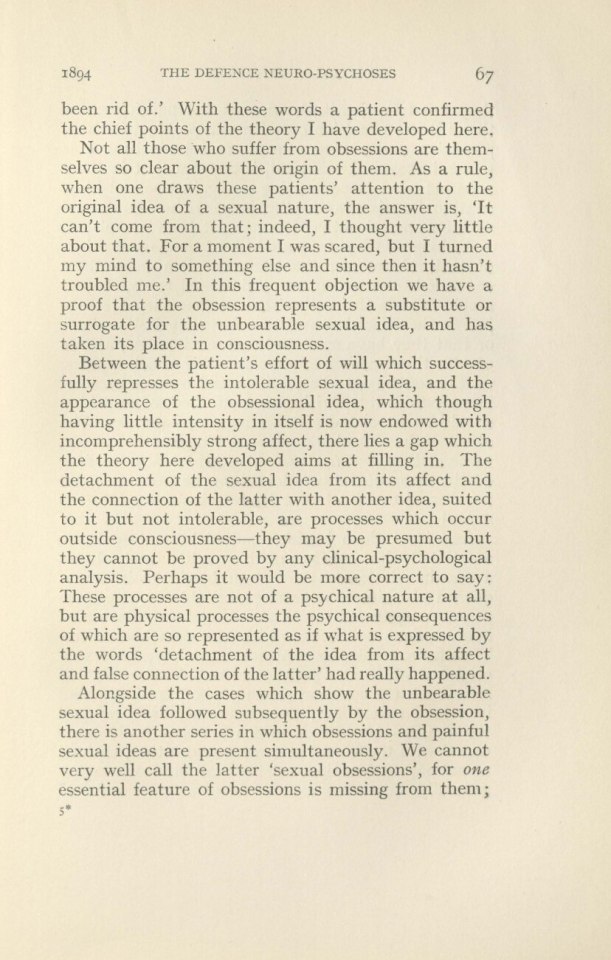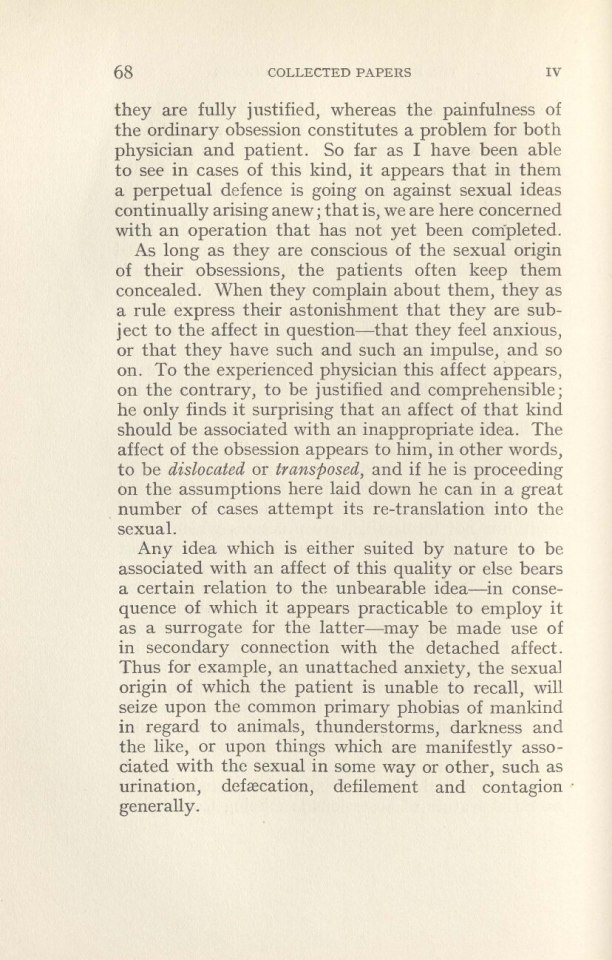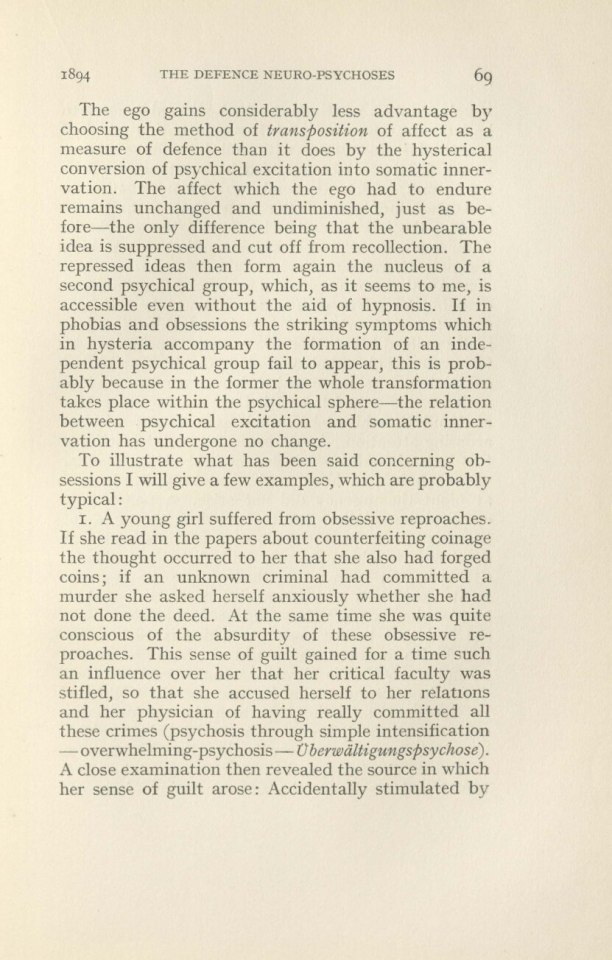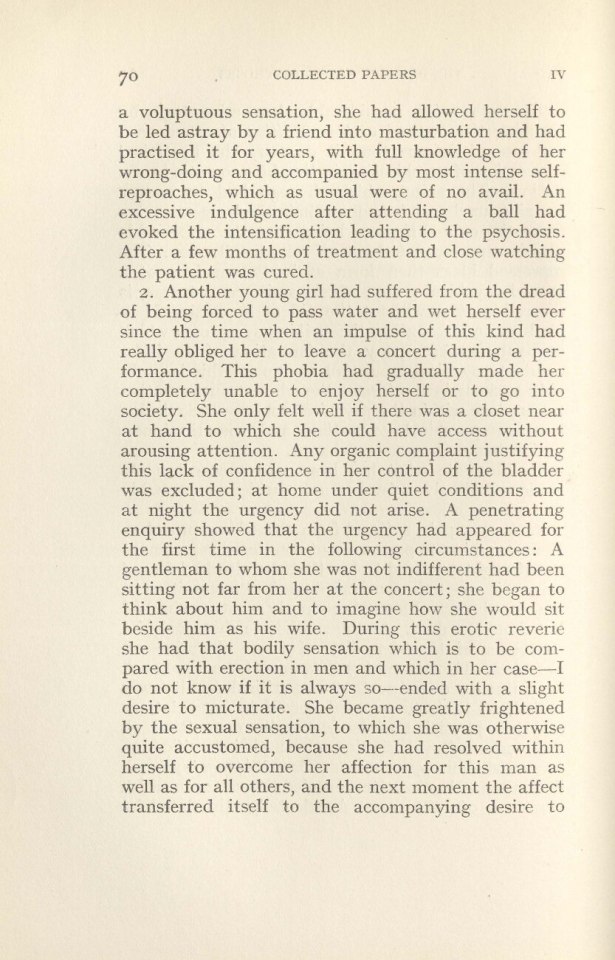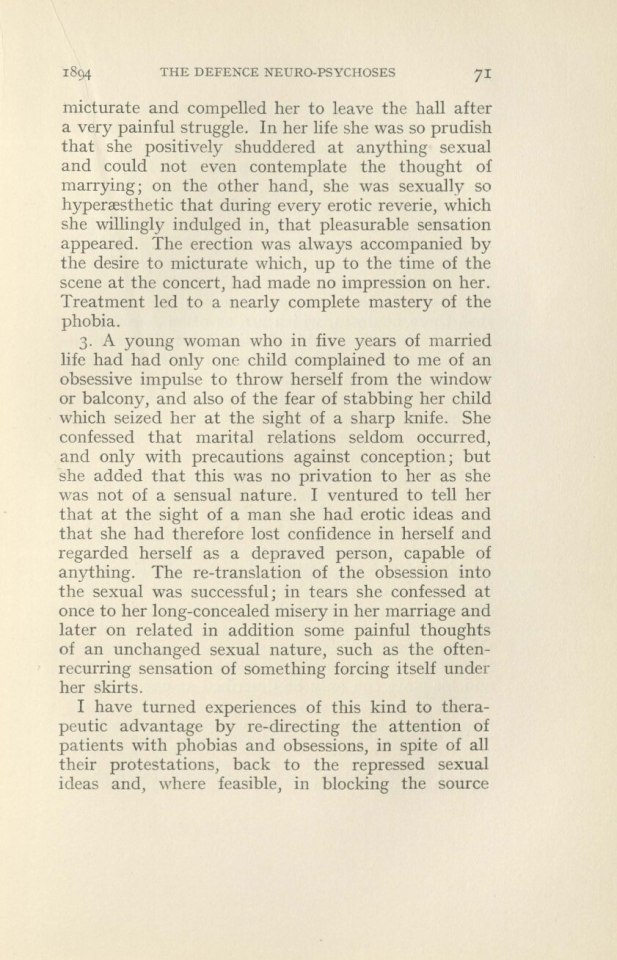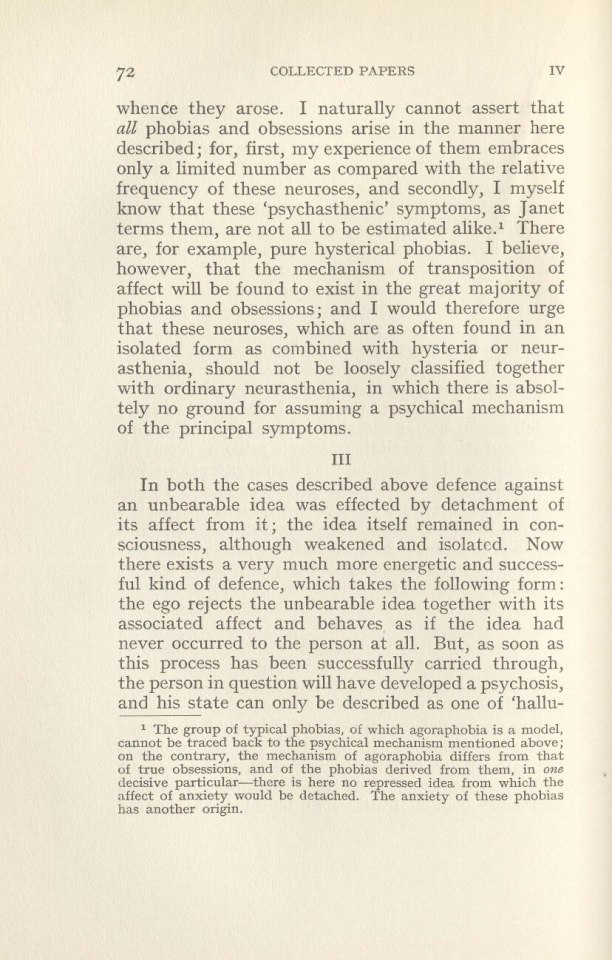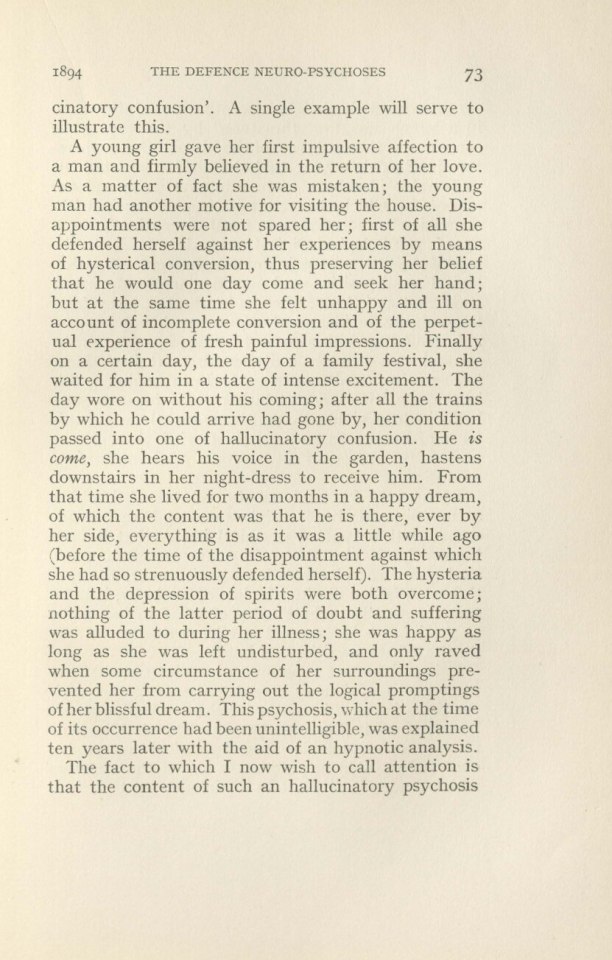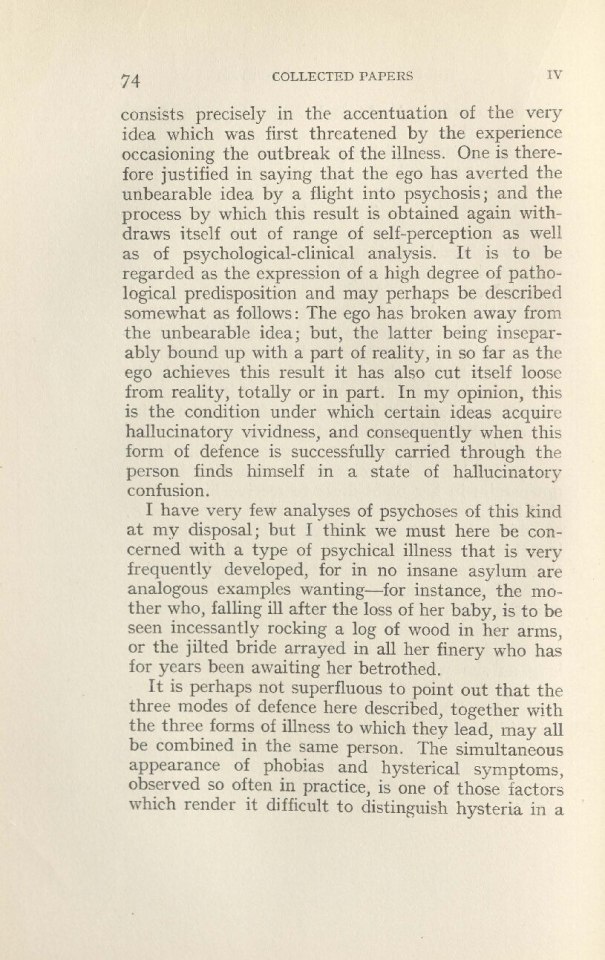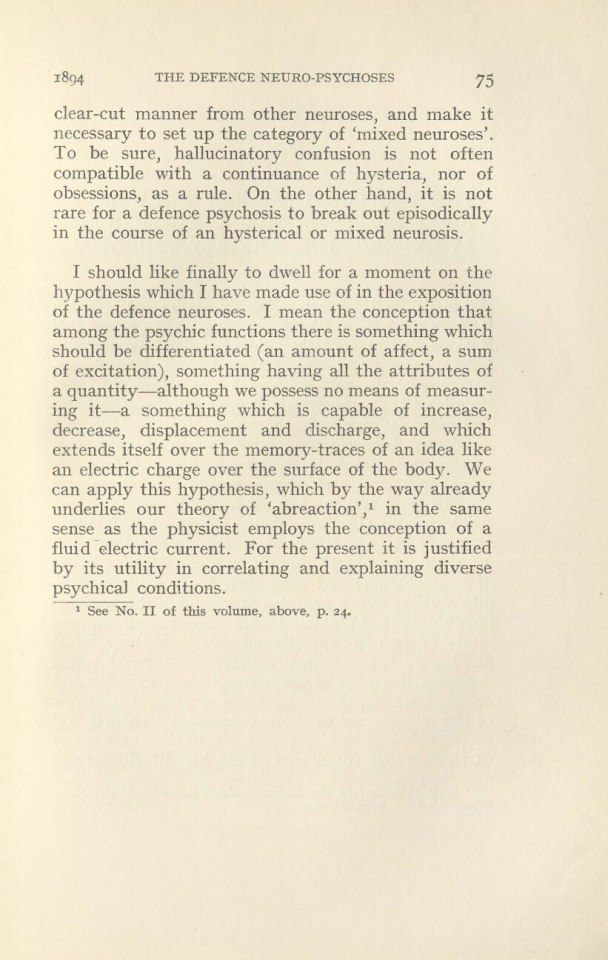S.
IV
THE DEFENCE NEURO-PSYCHOSES'
An endeavour to provide a psycho-
logical theory of acquired hysteria,
many phobias and obsessions, and
rtin hallucinatory psychoses.(1894)
fter a close study of several patients suffering
from phobias and obsessions a tentative eX-
planation of these symptoms forced itself upon
ine; and as it later enabled me successfully to divine
the origin of similar pathological ideas in other cases,
I consider it worthy of publication and of further
tests. Along with this “psychological theory of
phobias and obsessions’, observation of these patients
has resultedin a contribution to the theory of hysteria,
or rather an alteration in it, which appears to account
for an important characteristic common both to
hysteria and to the neuroses mentioned above.
Further, I had opportunities of gaining some insight
into the psychological mechanism of a form of disease
that is undoubtediy of mental origin, and then found
that the tentative point of view I had adopted esta-
blished an intelligible connection between these. psy-
choses and the two neuroses mentioned. At the end
of this essay I shall bring forward an hypothesis
which I have employed in all three cases.1
Let me begin with the alteration that in my view
we are called upon to make in the theory of the
hysterical neurosis.= Gasse published in the Neurologische Zentralblatt, 1894, Nos. 10
And 15 ranslated by John Rickman.]S.
bo \ COLLECTED PAPERS IV
Since the publication of the fine work carried out
by P. Janet, J. Breuer and others, it may be taken
as generally acknowledged that the syndrome of
hysteria, in so far as it permits of understanding up
to the present, justifies the concept of a splitting of
consciousness, with the formation of separate psych-
ical groups; opinions are less definite, however,
concerning the origin of this splitting of conscious-
ness and the part which this character plays in the
structure of the hysterical neurosis.According to Janet’s theory? the splitting of con-
sciousness is a primary feature of the hysterical
change. It is dependent on an inborn weakness in the
capacity for psychical synthesis, on the narrowness
of the ‘field of consciousness’ (champ du conscience)
which in the form of a psychic stigma is evidence of
the degeneration of hysterical persons.In contradistinction to Janet’s view, which seems
to me to admit of many and various objections, we
have that advocated by J. Breuer in our joint public-
ation?. According to Breuer, the ‘foundation and
condition’ of hysteria is the occurrence of peculiar
dream-like states of consciousness with diminished
capacity for association, for which he suggests the
name ‘hypnoid states’. The splitting of consciousness
is then secondary and acquired; it occurs because
the ideas which emerge in hypnoid states are cut off
from associative connection with the remaining
contents of consciousness.I can now bring forward evidence of two other more
extreme forms of hysteria in which it is impossible
to regard the splitting of consciousness as primary
in Janet’s sense. In the first of these forms I repeat-? Etat mental des hysteriques, Paris, 1803 and 1894. — Quelques
difinitions recentes de Y’'hysterie, Avchives de Neurologie, 1893,
XXXV—XXXVL2 See No. II of this volume, above, p. 24.
S.
1894 THE DEFENCE NEURO-PSYCHOSES 61
edly succeeded in demonstrating that the splitting
of the contents of consciousness is the consequence
of a voluntary act on the part of the patient; that is
to say, it is instituted by an effort of will, the motive
of which is discoverable. By this I do not of course
mean that the patient intends to produce a splitting
of his consciousness; the patient’s aim is a different
one, but instead of attaining its end it produces a
splitting of consciousness.In the third form of hysteria, as shown by the
mental analysis of intelligent patients, the splitting
of consciousness plays an insignificant part, or per-
haps none at all. These are the cases in which all
that had happened was that the reaction to traum-
atic stimuli had failed to occur, so that they are
accordingly dissolved and cured by ‘abreaction’!—
they are the pure ‘retention’ hysterias.In connection with what I have to say about
phobias and obsessions I shall here deal only with
the second form of hysteria, which for reasons that
will soon be evident I shall designate as defence
hysteria, and distinguish by this name from hypnoid
and vetention hysteria. I may also provisionally re-
present my cases of defence hysteria as cases of
“acquired hysteria’, because there was in them no
question either of grave hereditary taint or of indi-
vidual atrophic degeneration.These patients whom I analysed had enjoyed good
mental health up to the time at which an intolerable
idea presented itself within the content of their
ideational life; that is to say, until their ego was
confronted by an experience, an idea, a feeling,
arousing an affect so painful that the person resolved
to forget it, since he had no confidence in his powerı See No. II of this volume, above, p. 24.
S.
62 COLLECTED PAPERS IV
to resolve the incompatibility between the unbearable
idea and his ego by the processes of thought.Such unbearable ideas develop in women chiefly
in connection with sexual experiences and sensations,
and the patients can recollect with the most satis-
factory minuteness their efforts at defence—their
resolution to ‘push the thing out’, not to think of it,
to suppress it. I will give from my experience some
examples which I could casily multiply: A young
girl who disapproved of herself because while nursing
her sick father she had let her mind dwell on the
thought of a young man who had made a slight erotic
impression on her; a governess who had fallen in
love with her employer and had resolved to thrust
this affection from her mind because it appeared to
her incompatible with her pride; and so on.tI do not of course assert that an effort of will to
thrust such things out of the mind is a pathological
act, nor am I able to say whether and in what manner
intentional forgetting is successful in pcople who
remain healthy, although subject to similar mental
impressions. I only know that this kind of ‘forgetting’
did not succeed with the patients whom I analysed,
but led to various pathological reactions, giving rise
either to hysteria, or to an obsession, or to an hallu-
cinatory psychosis. The ability to bring about by
an effort of will one of these states, which are all of
them associated with splitting of consciousness, is to
be regarded as the manifestation of a pathological
disposition—which, however, is not necessarily ident-
ical with personal or hereditary ‘degeneration’.In regard to the intermediate processes between the
patient’s effort of will and the onset of the neurotic
symptom, I have formed an opinion which may be’ These examples are more fully described in Studien über Hysterie,
Breuer and Freud. 1895.S.
1894 THE DEFENCE NEURO-PSYCHOSES 63
expressed in the customary psychological abstractions
somewhat as follows: The task which the ego under-
takes in defence—of treating the unbearable idea as
‚non arrivee'—is absolutely insoluble; both the mem-
ory-trace and the affect attached to the idea are
there once and for all, and it is no longer possible to
extirpate them. But it amounts to an approximate
fulfilment of this task if the ego succeeds in trans-
forming a strong idea into a weak one, in depriving
it of its affect—the quantity of excitation with which
the idea is charged. The weak idea will then make
practically no demands on the work of association;
the quantity of excitation, however, which is then
detached from the idea, must be utilized in another
direction.Up to this point the processes are the same in
hysteria and in phobias and obsessions ; from now
onwards their ways diverge. In hysteria the unbear-
able idea is rendered innocuous by the quantity of
excitation attached to it being transmuted into some
bodily form of expression, a process for which I
should like to propose the name of conversion.The conversion may be either total or partial, and
it proceeds along the line of the motor or sensory
innervation that is more or less intimately related to
the traumatic experience. Thus the ego succeeds in
resolving the incompatibility within itself; but instead
it has burdened itself with a memory-symbol, which
dwells in consciousness, like a sort of parasite, either
in the form of a persistent motor innervation or else
as a constantly recurring hallucinatory sensation,
and remains until a reversion takes place in the
opposite direction. The memory-trace of the repressed
idea is not, however, annihilated by this process ;
on the contrary, from now onwards it forms the
nucleus of a secondary psychical group.S.
04 COLLECTED PAPERS Wv
I will only add a few more words to this conception
of the psycho-physical processes in hysteria. When
once such a nucleus of an hysterical splitting has been
formed owing to a “traumatic’ factor it will be
developed by the influence of other factors (which
might be called ‘auxiliary traumatic’ factors) as
soon as an impression of a similar kind, subsequently
experienced, succeeds in breaking through the barriers
erected by the will, in furnishing the weakened idea
with fresh affect and in re-establishing for a time an
associative connection between the two psychical
groups—until a further conversion creates a defence
against it. The distribution of exeitation thus brought
about in hysteria proves as a rule an unstable one;
the excitation which is directed into a wrong channel
(into somatic innervation) now and then finds its
way back to the idea from which it was detached, and
then compels the subject either to undertake the
work of associative absorption or else to discharge
it by the way of hysterical attacks—a conclusion
which is supported by the familiar opposition between
the hysterical attack and chronic symptoms. Breuer’s
cathartic method achieves its results by deliberately
effecting such a re-transmutation of the excitation
{rom the somatic into the mental field, in order then
to enforce a resolution of the opposed elements by
a process of thought and a discharge of the excitation
in speech.The conclusion that the splitting of consciousness
in acquired hysteria is based on an act of will also
explains with surprising simplicity the remarkable
fact that hypnosis regularly widens the narrowed
consciousness of the hysteric and makes the psychical
group which has been split off accessible. Indeed, we
know it to be a peculiarity of all sleep-like conditions
that thev abrogate that distribution of excitationS.
1894 THE DEFENCE NEURO-PSYCHOSES 65
upon which the ‘will’ of the conscious personality
depends.Thus we can see that the characteristic factor in
hysteria is not to be found in the splitting of conscious-
ness but in the capacity for conversion, and we may
assume that the psycho-physical capacity to trans-
mute such large quantities of excitation into somatic
innervation is an important element of the dis-
position to hysteria, which in other respects is still
unknown.This capacity does not in itself preclude mental
health and leads to hysteria only where there is some
mental incompatibility or an accumulation of ex-
citation. With this new turn in the theory Breuer
and I approach Oppenheim’s! and Strümpell’s® well-
known definition of hysteria, and recede from Janet?
who assigns too great importance to the splitting of
consciousness as a characteristic of hysteria. The
presentation here given may claim to have rendered
the relation between conversion and the hysterical
splitting of consciousness intelligible.u
If the capacity for conversion does not exist in a
person predisposed to hysteria and yet the separation
of its affect from an unbearable idea is nevertheless3 Oppenheim: Hysteria is an intensified expression of emotion.
The ‘expression of emotion’, however, represents that quantity ol
the psychical excitation which normally undergoes conversion.3 Strümpell: In hysteria the disturbance lies in the psycho-
physical sphere, where body and mind have their connection with
each other.® In the second edition of his ingenious paper, ‘Quelgues defini-
tions, etc’, Janet has himself dealt with the objection that splitting
of consciousness occurs also in the psychoses and in psychasthenia,
so-called, but in my judgement he has not solved the difficulty
satisfactorily. It is essentially this objection that has forced him
to regard hysteria as a form of degeneration. He cannot, however,
adequately distinguish the hysterical splitting of conseiousness from
he psychotic and other such forms by any characterization.g
S.
66 COLLECTED PAPERS Wv
undertaken as a defence against the latter, then this
affect must persist in the psychical sphere. Thus
weakened, the idea remains present in consciousness,
detached from all associations; but its affect, now
freed from it, attaches itself to other ideas which
are not in themselves unbearable, but which through
this ‘false connection’ grow to be obsessions. This
is shortly the psychological theory of obsessions and
phobias which I mentioned to start with.I will now enumerate the various elements necess-
ary to the structure of this theory that admit of
direct proof, and then describe those that I have
myself supplied. Apart from the final result of the
process, that is, the obsession, it is possible in the
first place to demonstrate the ultimate source of
the affect which is now falsely attached to some other
idea. In all the cases I have analysed it was in the
sexual life that a painful affect—of precisely the
same quality as that attaching to the obsession—had
originated. On theoretical grounds it is not impossible
that this affect may at times arise in other spheres; I
have merely to state that hitherto I have not dis-
covered any other origin of it. Incidentally, it is
easy to see that it is precisely in regard to the sexual
life that unbearable ideas most frequently arise.Further, we have the most unequivocal utterances
on the part of patients in proof of the effort of will,
the attempt at defence, upon which the theory lays
emphasis; and in at least a number of cases the
patients themselves will inform us of the fact that
the phobia or obsession first made its appearance
after this effort of will had apparently succeeded in
its aim. ‘Once something very disagreeable happened
to me, and I did my utmost to thrust it out of my
mind, to think no more about it. Finally I succeeded,
but then I got this, which since then I have neverS.
1894 THE DEFENCE NEURO-PSYCHOSES 67
been rid of.” With these words a patient confirmed
the chief points of the theory I have developed here.Not all those who suffer from obsessions are them-
selves so clear about the origin of them. Asa rule,
when one draws these patients’ attention to the
original idea of a sexual nature, the answer is, ‘It
can’t come from that; indeed, I thought very little
about that. For a moment I was scared, but I turned
my mind to something else and since then it hasn’t
troubled me.’ In this frequent objection we have a
proof that the obsession represents a substitute or
surrogate for the unbearable sexual idea, and has
taken its place in consciousness.Between the patient’s effort of will which success-
fully represses the intolerable sexual idea, and the
appearance of the obsessional idea, which though
having little intensity in itself is now endowed with
incomprehensibly strong affect, there lies a gap which
the theory here developed aims at filling in. The
detachment of the sexual idea from its affect and
the connection of the latter with another idea, suited
to it but not intolerable, are processes which occur
outside consciousness—they may be presumed but
they cannot be proved by any clinical-psychological
analysis. Perhaps it would be more correct to say:
These processes are not of a psychical nature at all,
but are physical processes the psychical consequences
of which are so represented as if what is expressed by
the words ‘detachment of the idea from its affect
and false connection of the latter’ had really happened.Alongside the cases which show the unbearable
sexual idea followed subsequently by the obsession,
there is another series in which obsessions and painful
sexual ideas are present simultaneously. We cannot
very well call the latter ‘sexual obsessions’, for one
essential feature of obsessions is missing from them;.*
5:S.
COLLECTED PAPERS WwV
they are fully justified, whereas the painfulness of
the ordinary obsession constitutes a problem for both
physician and patient. So far as I have been able
to see in cases of this kind, it appears that in them
a perpetual defence is going on against sexual ideas
continually arising anew ; that is, we are here concerned
with an operation that has not yet been completed.As long as they are conscious of the sexual origin
of their obsessions, the patients often keep them
concealed. When they complain about them, they as
a rule express their astonishment that they are sub-
ject to the affect in question—that they feel anxious,
or that they have such and such an impulse, and so
on. To the experienced physician this affect appears,
on the contrary, to be justified and comprehensible;
he only finds it surprising that an affect of that kind
should be associated with an inappropriate idea. The
affect of the obsession appears to him, in other words,
to be dislocated or transposed, and if he is proceeding
on the assumptions here laid down he can in a great
number of cases attempt its re-translation into the
sexual.Any idea which is either suited by nature to be
associated with an affect of this quality or else bears
a certain relation to the unbearable idea—in conse-
quence of which it appears practicable to employ it
as a surrogate for the latter—may be made use of
in secondary connection with the detached affect.
Thus for example, an unattached anxiety, the sexual
origin of which the patient is unable to recall, will
seize upon the common primary phobias of mankind
in regard to animals, thunderstorms, darkness and
the like, or upon things which are manifestly asso-
ciated with the sexual in some way or other, such as
urination, defscation, defilement and contagion
generally.S.
1894 THE DEFENCE NEURO-PSYCHOSES 69
The ego gains considerably less advantage by
choosing the method of iransposition of affect as a
measure of defence than it does by the hysterical
conversion of psychical exeitation into somatic inner-
vation. The affect which the ego had to endure
remains unchanged and undiminished, just as be-
fore—the only difference being that the unbearable
idea is suppressed and cut off from recollection. The
repressed ideas then form again the nucleus of a
second psychical group, which, as it seems to me, is
accessible even without the aid of hypnosis. If in
phobias and obsessions the striking symptoms which
in hysteria accompany the formation of an inde-
pendent psychical group fail to appear, this is prob-
ably because in the former the whole transformation
takes place within the psychical sphere—the relation
between psychical excitation and somatic inner-
vation has undergone no change.To illustrate what has been said concerning ob-
sessions I will give a few examples, which are probably
typical:1. A young girl suffered from obsessive reproaches.
If she read in the papers about counterfeiting coinage
the thought occurred to her that she also had forged
coins; if an unknown criminal had committed a
murder she asked herself anxiousiy whether she had
not done the deed. At the same time she was quite
conscious of the absurdity of these obsessive re-
proaches. This sense of guilt gained for a time such
an influence over her that her critical faculty was
stifled, so that she accused herself to her relatıons
and her physician of having really committed all
these crimes (psychosis through simple intensification
—overwhelming-psychosis—Ü! berwältigungspsychose).
A close examination then revealed the source in which
her sense of guilt arose: Accidentally stimulated byS.
79 . COLLECIED PAPERS IN
a voluptuous sensation, she had allowed herself to
be led astray by a friend into masturbation and had
practised it for years, with full knowledge of her
wrong-doing and accompanied by most intense self-
reproaches, which as usual were of no avail. An
excessive indulgence after attending a ball had
evoked the intensification leading to the psychosis.
After a few months of treatment and close watching
the patient was cured.2. Another young girl had suffered from the dread
of being forced to pass water and wet herself ever
since the time when an impulse of this kind had
really obliged her to leave a concert during a per-
formance. This phobia had gradually made her
completely unable to enjoy herself or to go into
society. She only felt well if there was a closet near
at hand to which she could have access without
arousing attention. Any organic complaint justifying
this lack of confidence in her control of the bladder
was excluded; at home under quiet conditions and
at night the urgency did not arise. A penetrating
enquiry showed that the urgency had appeared for
the first time in the following circumstances: A
gentleman to whom she was not indifferent had been
sitting not far from her at the concert; she began to
think about him and to imagine how she would sit
beside him as his wife. During this erotic reverie
she had that bodily sensation which is to be com-
pared with erection in men and which in her casc—I
do not know if it is always so—ended with a slight
desire to micturate. She became greatly frightened
by the sexual sensation, to which she was otherwise
quite accustomed, because she had resolved within
herself to overcome her affection for this man as
well as for all others, and the next moment the affect
transferred itself to the accompanying desire toS.
1894 THE DEFENCE NEURO-PSYCHOSES
micturate and compelled her to leave the hall after
a very painful struggle. In her life she was so prudish
that ‘she positively shuddered at anything sexual
and could not even contemplate the thought of
marrying; on the other hand, she was sexually so
hyperzsthetic that during every erotic reverie, which
she willingly indulged in, that pleasurable sensation
appeared. The erection was always accompanied by
the desire to micturate which, up to the time of the
scene at the concert, had made no impression on her.
Treatment led to a nearly complete mastery of the
phobia.3. A young woman who in five years of married
life had’had only one child complained to me of an
obsessive impulse to throw herself from the window
or balcony, and also of the fear of stabbing her child
which seized her at the sight of a sharp knife. She
confessed that marital relations seldom occurred,
and only with precautions against conception; but
she added that this was no privation to her as she
was not of a sensual nature. I ventured to tell her
that at the sight of a man she had erotic ideas and
that she had therefore lost confidence in herself and
regarded herself as a depraved person, capable of
anything. The re-translation of the obsession into
the sexual was successful; in tears she confessed at
once to her long-concealed misery in her marriage and
later on related in addition some painful thoughts
of an unchanged sexual nature, such as the often-
recurring sensation of something foreing itself under
her skirts.I have turned experiences of this kind to thera-
peutic advantage by re-directing the attention of
patients with phobias and obsessions, in spite of all
their protestations, back to the repressed sexual
ideas and, where feasible, in blocking the sourceS.
72 COLLECTED PAPERS IV
whence they arose. I naturally cannot assert that
all phobias and obsessions arise in the manner here
described; for, first, my experience of them embraces
only a limited number as compared with the relative
frequency of these neuroses, and secondly, I myself
know that these ‘psychasthenic’ symptoms, as Janet
terms them, are not all to be estimated alike.* There
are, for example, pure hysterical phobias. I believe,
however, that the mechanism of transposition of
affect will be found to exist in the great majority of
phobias and obsessions; and I would therefore urge
that these neuroses, which are as often found in an
isolated form as combined with hysteria or neur-
asthenia, should not be loosely classified together
with ordinary neurasthenia, in which there is absol-
tely no ground for assuming a psychical mechanism
of the principal symptoms.II
In both the cases described above defence against
an unbearable idea was effected by detachment of
its affect from it; the idea itself remained in con-
sciousness, although weakened and isolated. Now
there exists a very much more energetic and success-
ful kind of defence, which takes the following form:
the ego rejects the unbearable idea together with its
associated affect and behaves as if the idea had
never occurred to the person at all. But, as soon as
this process has been successfully carried through,
the person in question will have developed a psychosis,
and his state can only be described as one of ‘hallu-i The group of typical phobias, of which agoraphobia is a model,
cannot be traced back to the psychical mechanism mentioned above;
on the contrary, the mechanism of agoraphobia differs from that
of true obsessions, and of the phobias derived from them, in one
decisive particular—there is here no repressed idea from which theaffect of anxiety would be detached. The anxiety of these phobias
has another origin.S.
1894 THE DEFENCE NEURO-PSYCHOSES 73
cinatory confusion’. A single example will serve to
illustrate this.A young girl gave her first impulsive affection to
a man and firmly believed in the return of her love.
As a matter of fact she was mistaken; the young
man had another motive for visiting the house. Dis-
appointments were not spared her; first of all she
defended herself against her experiences by means
of hysterical conversion, thus preserving her belief
that he would one day come and seek her hand;
but at the same time she felt unhappy and ill on
account of incomplete conversion and of the perpet-
ual experience of fresh painful impressions. Finally
on a certain day, the day of a family festival, she
waited for him in a state of intense excitement. The
day wore on without his coming; after all the trains
by which he could arrive had gone by, her condition
passed into one of hallucinatory confusion. He is
come, she hears his voice in the garden, hastens
downstairs in her night-dress to receive him. From
that time she lived for two months in a happy dream,
of which the content was that he is there, ever by
her side, everything is as it was a little while ago
(before the time of the disappointment against which
she had so strenuously defended herself). The hysteria
and the depression of spirits were both overcome;
nothing of the latter period of doubt and suffering
was alluded to during her illness; she was happy as
long as she was left undisturbed, and only raved
when some circumstance of her surroundings pre-
vented her from carrying out the logical promptings
of her blissful dream. This psychosis, which at the time
of its occurrence had been unintelligible, was explained
ten years later with the aid of an hypnotic analysis.The fact to which I now wish to call attention is
that the content of such an hallucinatory psychosisS.
74 COLLECTED PAPERS IV
consists precisely in the accentuation of the very
idea which was first threatened by the experience
occasioning the outbreak of the illness. One is there-
fore justified in saying that the ego has averted the
unbearable idea by a flight into psychosis; and the
process by which this result is obtained again with-
draws itsclf out of range of self-perception as well
as of psychological-clinical analysis. It is to be
regarded as the expression of a high degree of patho-
logical predisposition and may perhaps be described
somewhat as follows: The ego has broken away from
the unbearable idea; but, the latter being insepar-
ably bound up with a part of reality, in so far as the
ego achieves this result it has also cut itself loosc
irom reality, totally or in part. In my opinion, this
is the condition under which certain ideas acquire
hallucinatory vividness, and consequently when this
form of defence is successfully carried through the
person finds himself in a state of hallucinatory
confusion.I have very few analyses of psychoses of this kind
at my disposal; but I think we must here be con-
cerned with a type of psychical illness that is very
frequently developed, for in no insane asylum are
analogous examples wanting—for instance, the mo-
ther who, falling ill after the loss of her baby, is to be
seen incessantly rocking a log of wood in her arms,
or the jilted bride arrayed in all her finery who has
for years been awaiting her betrothed.It is perhaps not superfluous to point out that the
three modes of defence here described, together with
the three forms of illness to which they lead, may all
be combined in the same person. The simultaneous
appearance of phobias and hysterical symptoms,
observed so often in practice, is one of those factors
which render it difficult to distinguish hysteria in aS.
1894 THE DEFENCE NEURO-PSYCHOSES 75
clear-cut manner from other neuroses, and make it
necessary to set up the category of ‘mixed neuroses’.
To be sure, hallucinatory confusion is not often
compatible with a continuance of hysteria, nor of
obsessions, as a rule. On the other hand, it is not
rare for a defence psychosis to break out episodically
in the course of an hysterical or mixed neurosis.I should like finally to dwell for a moment on the
hypothesis which I have made use of in the exposition
of the defence neuroses. I mean the conception that
among the psychic functions there is something which
should be differentiated (an amount of affect, a sum
of exeitation), something having all the attributes of
a quantity—although we possess no means of measur-
ing it—a something which is capable of increase,
decrease, displacement and discharge, and which
extends itself over the memory-traces of an idea like
an electric charge over the surface of the body. We
can apply this hypothesis, which by the way already
underlies our theory of ‘abreaction’,' in the same
sense as the physicist employs the conception of a
fluid electric current. For the present it is justified
by its utility in correlating and explaining diverse
psychical conditions."2 See No. II of this volume, above, p. 24.
An endeavour to provide a psychological theory of acquired hysteria, many phobias and obsessions, and certain hallucinatory psychoses
freud-1924-cp-1
59
–75
